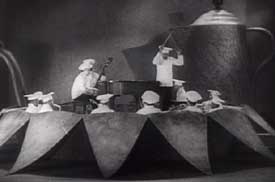 Nina Mae McKinney, dressed absurdly like Aunt Jemima, has just finished baking a pie, at the beginning of the Vitaphone one-reel musical short Pie, Pie, Blackbird (1932). She sings "Blackbird Pie" to the exceedingly young Nicholas Brothers: Nina Mae McKinney, dressed absurdly like Aunt Jemima, has just finished baking a pie, at the beginning of the Vitaphone one-reel musical short Pie, Pie, Blackbird (1932). She sings "Blackbird Pie" to the exceedingly young Nicholas Brothers:
"Nina's place is in the kitchen/ Heres the reason why/ Master sez it takes a blackbird/ To make the sweetest kind of bread."
These are terrible, terrible lyrics & demeaning as all hell. But Nina Mae sings this bad song as well as bad songs can be sung.
Suddenly the pie bursts open & inside it are Eubie Blake & his band! Oki-doki, this is some wee movie after all!
The band starts off with a bit of classical music, but then go into mellow swing. A giant coffee pot is part of the outsized set. Everybody is wearing chef uniforms including hats.
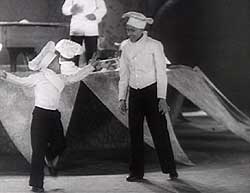 Eubie leaps up from his piano, doffs hat, & speeds up the jazz quartet. Jump-cut to another shot of the same amusing set of giant props, but now Nina Mae sitting on the piano singing "Everything That I've Got Belongs to You" & gazing at the camera with enough charm to stop a heart. Eubie leaps up from his piano, doffs hat, & speeds up the jazz quartet. Jump-cut to another shot of the same amusing set of giant props, but now Nina Mae sitting on the piano singing "Everything That I've Got Belongs to You" & gazing at the camera with enough charm to stop a heart.
Nina Mae is simultaneously in the kitchen with the Nicholas Brothers watching her miniature self sing & Eubie's band perform in & around the pie.
Tiny-Nina does some scat & some growly horn sounds. Wha-da-Q-T! Jump-cut again to the same set, but Nina's gone, & we get a rendition of "I'll Be Glad When You're Gone You Rascal You" sung by Eubie. This crazy featurette is just nonstop fun!
Next the young Nicholases stroll around to the front of the pie wearing chef hats & do one of their splendid tap routines while Eubie's band plays "China Boy."
Those young lads dance so fast their feet set the floor on fire. And for the big finale, everyone gets burned up in the fire & skeletons are still tapdancing & the skeleton-band is still playing.
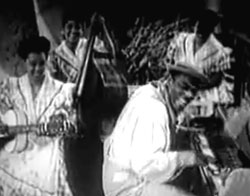 Gene Rodgers is seated at an upright piano in Juke Box Boogie (1944). He's backed up by an all-girl quartet with guitar, two slap basses, a drummer, & the fifth girl seated near Gene but without an instrument.
Gene Rodgers is seated at an upright piano in Juke Box Boogie (1944). He's backed up by an all-girl quartet with guitar, two slap basses, a drummer, & the fifth girl seated near Gene but without an instrument.
If by his antics "Gene" seems as much comic as pianist it's because the name Gene Rodgers was a pseudonym for vaudeville comedian Morton Harvey (1886-1961), a name he first used when he was recording ragtime numbers for Emerson Records in the 'teens.
Way-back-when, he'd also recorded under his own name with Victor & Edison. So yeah, he's a lot older than he looks in the 1944 soundie. His grampa was a successful cattleman who founded the town of Harvey, Illinois, & his family had been grooming him to be a preacher. But he had his own notions of how his future should run, & headed off to Chicago where he got his first gigs as a saloon pianist.
He was the first musician ever (in 1914) to record W. C. Handy's "Memphis Blues." Several of his 1914-1916 records have "blues" in the title which was not a commonplace until 1917 or so. So while his records weren't generally best sellers of the day, he seems to have influenced other artists in their title choices.
He also had a hit anti-war song in 1915 "I Didn't Raise My Son to Be a Soldier." While America stayed out of the war in Europe he won considerable popularity for this number. But when America did finally enter the war, the song came to be regarded as unpatriotic, & Morton's recording career came to a screeching halt.
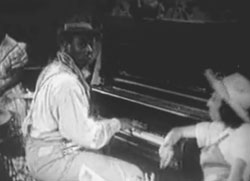 Morton's playing in Juke Box Boogie is a fairly standard but very good barrelhouse boogie, with plenty of mugging to the camera & goofing about. Morton's playing in Juke Box Boogie is a fairly standard but very good barrelhouse boogie, with plenty of mugging to the camera & goofing about.
The all-girl band is called "the V's" & they back up Gene on three soundies total, which seems to represent the sum total of their history. Their name would seem to be a reference to Victory.
Chances are this was his wife Betty's band. Morton & Betty had managed a radio station in Oklahoma for a couple decades, but during the war years they came out to California, where Betty was a vocal coach & piano teacher while her husband was manager for the War Manpower Commission in San Francisco & also for the nearby Army hospital.
He & Betty had long been semi-retired from performing & when the war was over Morton ran a photography studio in Los Gatos. Yet show business once in the blood never leaves & Morton found time for occasional performances, & can even be seen at the piano in a cafe scene in the feature film That's My Baby (1944).
For Juke Box Boogie the stage is decked out to look like it might be barn's interior but a mite too refined for livestock, evoking an ad hoc rural jazz club. The V's are wearing long gingam dresses; for a soundie which sold sex appeal as well as music, the conservative garb is unusual.
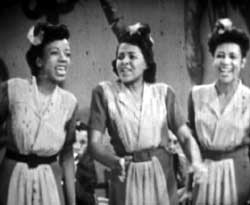 IIn 1939 Marion Hutton with the Glenn Miller Orchestra had a hit with "Wham! Re-Bop-Boom-Bam." The number was beautifully covered by The Ginger Snaps in the soundie Wham! (1943).
IIn 1939 Marion Hutton with the Glenn Miller Orchestra had a hit with "Wham! Re-Bop-Boom-Bam." The number was beautifully covered by The Ginger Snaps in the soundie Wham! (1943).
One of the Ginger Snaps is Ethel Ernestine Harper, who in the 1950s made personal appearances as Aunt Jemima representing Quaker Oats. Nothing of that mammy stereotype is evident in this soundie, however, as these are simply young talented women.
The soundie starts off with choras girls dancing like mad with the Ginger Snaps obscured on a short stage in the background. It then cuts to the harmony group, who were usually called The Four Ginger Snaps, consisting of three girl singers & sometimes a fourth member, male.
They were alternatively billed just as The Ginger Snaps. As a trio they release four singles (eight songs including B sides) between 1945 & 1947, including "Juke Box Joe" "Shrimp Man," & "I Left My Heart in Mississippi." But up to 1944 they'd had the fourth member, yet I can't spot him in Wham! though conceivably he's one of the musicians in the far back of the stage.
We're treated to a brilliantly fun jump-jazz beat & lyrics: "I can swing & I can jam/ I'm a killer diller yes I am/ When you learn it you'll be proud/ Join the crowd & sing out loud..."
It's somewhat call & respond in that each line of lyric done by the middle Ginger Snap has the two flanking Ginger Snaps harmonizing the phrase "Wham! Re-bop-boom-bam." It's just absolute fun.
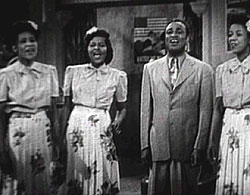 "The Ginger Snaps" as "The Four Ginger Snaps" was the same three gals plusa guy. They saunter center stage in an arcade setting, laughing goofily before they begin the lyrics in the soundie Keep Smiling (1943).
"The Ginger Snaps" as "The Four Ginger Snaps" was the same three gals plusa guy. They saunter center stage in an arcade setting, laughing goofily before they begin the lyrics in the soundie Keep Smiling (1943).
They most amusingly take on seriously severe expressions to sing: "Let's keep smilin'/ Let's keep laughin'/ Let's be hapPEEEE, ho ho ho ho." They don't crack the slightest smiles & seem more likely to slap someone's kid.
By the second verse they cease the frowny shtick & begin smiling & swaying to the not-so-hot pop tune.
Halfway through it turns into one of those boogyin' advertisements for war bonds, with another verse having the catch phrase "get the Fuhrer! Get the Fuhrer!" as all the while the Four Ginger Snaps mug for the camera without the least subtlty. Ultimately the "let's keep laughing" during deadly warfare is kind of nutty.
In the background there's ticket vendor selling tickets for people top enter the arcade's "miniature circus." We alas are shown no clue of what the little circus is.
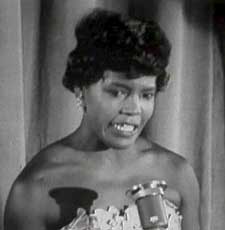 Faye Adams nee Fanny Tuell, with a great big voice emanating from her small body, stands in a founcy gown in the spotlight, sings her gorgeous heart out in the Studio Telescription Somebody Somewhere (1954), filmed in Manhattan's Studio Films, Inc., the same day as they recorded her performance of Every Day (1954).
Faye Adams nee Fanny Tuell, with a great big voice emanating from her small body, stands in a founcy gown in the spotlight, sings her gorgeous heart out in the Studio Telescription Somebody Somewhere (1954), filmed in Manhattan's Studio Films, Inc., the same day as they recorded her performance of Every Day (1954).
"Somebody somewhere must be prayin' for me/ Somebody somewhere must be prayin' for me/ Somebody somewhere must be prayin' for me/ I'd sure like to thank who it may be.
"I never done no wrong deed against nobody else/ The only things I done wrong, I did them to myself/ Yeah bad luck always jinxed me, can't stay out every night/ But something strange has happened & now I see the light."
This strikingly brilliant R & B is from an era verging into pure rock 'n' roll. It had been a chart hit, the single recorded with the Joe Morris Orchestra, Joe being a first-rate trumpeter.
But the telescription is a distinct live performance, & the super trumpet solo I presume is one of the guys from the Paul Williams Sextet, although Faye sang with the Joe Morris band until August 1954 & she & Morris performed at the Apollo together earlier that year.
This telescription was stitched into the half-hour television special Showtime at the Apollo: Basin Street Revue (1955) which pretends to be a live concert at the Apollo Theater though the trumped-up "concert" is a collection of telescriptions filmned from 1950 to 1954, inserting Willie Bryant as host to give it the general look of a single variety night at the Apollo.
In the mid-50s Faye was one of the best selling R & B artists going full tilt performing all across America. Cross-over hits evaded her, however, & before the '50s had come to a close, black vocalists who had not reached white teenagers were having their contracts dropped one after another.
After 1957, Faye bounced from label to label with inadequate support & none of the expected cross-over appeal, so she returned to her gospel roots, & the secular R & B lost one of its greatest voices.
copyright © by Paghat the Ratgirl
|
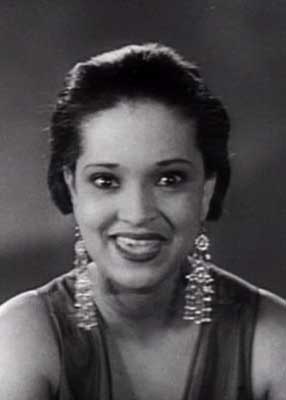

 Eubie leaps up from his piano, doffs hat, & speeds up the jazz quartet. Jump-cut to another shot of the same amusing set of giant props, but now Nina Mae sitting on the piano singing "Everything That I've Got Belongs to You" & gazing at the camera with enough charm to stop a heart.
Eubie leaps up from his piano, doffs hat, & speeds up the jazz quartet. Jump-cut to another shot of the same amusing set of giant props, but now Nina Mae sitting on the piano singing "Everything That I've Got Belongs to You" & gazing at the camera with enough charm to stop a heart.
 Morton's playing in Juke Box Boogie is a fairly standard but very good barrelhouse boogie, with plenty of mugging to the camera & goofing about.
Morton's playing in Juke Box Boogie is a fairly standard but very good barrelhouse boogie, with plenty of mugging to the camera & goofing about.

